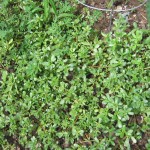 There are one or two weeds that can be confused with dandelions. On the left is prickly lettuce. The differences are quite evident when you see them together. Dandelions have very deep serrations on the leaf and prickly lettuce leaves are relatively smooth. Dandelion leaves grow in a rosette without a stem, and prickly lettuce has a stem with opposing leaves. Most evident of all, prickly lettuce has a single row of ‘hooks’ or prickles along the central rib on the back of the leaf, and dandelion’s leaf back is smooth.
There are one or two weeds that can be confused with dandelions. On the left is prickly lettuce. The differences are quite evident when you see them together. Dandelions have very deep serrations on the leaf and prickly lettuce leaves are relatively smooth. Dandelion leaves grow in a rosette without a stem, and prickly lettuce has a stem with opposing leaves. Most evident of all, prickly lettuce has a single row of ‘hooks’ or prickles along the central rib on the back of the leaf, and dandelion’s leaf back is smooth.
The whole dandelion plant is edible and nutritious – root, leaves, and flowers. It grows in most climates and terrains, although the growing season is dependent on seasonal rains in the desert. This is a valuable survival plant as it will keep you alive even if you have nothing else to eat. It contains all the nutritive salts the body needs to purify the blood and is a liver tonic as well as a safe diuretic since it replenishes the potassium as it does its job. Dandelion is also an excellent source of protein, calcium, potassium, and contains vitamins A, B, C, and E. It also supplies phosphorus and iron as well as some nickel, cobalt, tin, copper, and zinc.*
Dandelion root has been roasted for a coffee substitute, and the leaves are wonderful in salad when young and a good pot herb when older. The flowers can be dipped in batter and fried for a treat! There is a wonderful recipe for Dandelion and Bacon Salad at http://www.boulderlocavore.com/2011/05/warm-dandelion-and-bacon-salad.html and this is one of my favorite blogs as well!
* Today’s Herbal Health, 3rd Edition, by Louise Tenney, M.H., 1992, pg. 57.

 This is a fast growing, delicious and abundant succulent found in most gardens and wherever there is well drained soil and sun. It is more a ground cover than an upright plant and can extend to a foot and a half or more from the main root, with the branches rooting in places where it is in firm contact with the ground. Purslane has been used as a food and a medicinal in the Mediterranean Basin, India, and Asia for thousands of years. The leaves and stems have a slightly crunchy texture and a salty, slightly lemony flavor.
This is a fast growing, delicious and abundant succulent found in most gardens and wherever there is well drained soil and sun. It is more a ground cover than an upright plant and can extend to a foot and a half or more from the main root, with the branches rooting in places where it is in firm contact with the ground. Purslane has been used as a food and a medicinal in the Mediterranean Basin, India, and Asia for thousands of years. The leaves and stems have a slightly crunchy texture and a salty, slightly lemony flavor.
